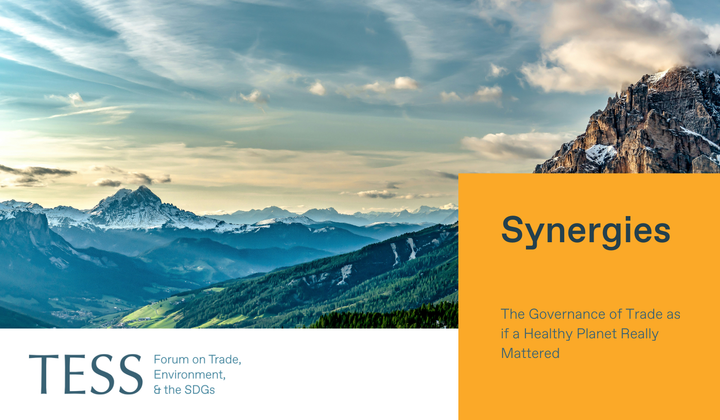Healthy ecosystems and thriving biodiversity underpin the stability of the global economy, but their value is not reflected in investment decisions due to sustained market failure. Fundamental reforms are needed to tilt financial incentives away from nature’s destruction towards its protection and restoration. The future landscape for nature financing needs be shaped by those who are on the front line of nature protection.
Healthy ecosystems and thriving biodiversity underpin the stability of the global economy, but their value is not reflected in investment decisions due to sustained market failure. Fundamental reforms are needed to tilt financial incentives away from nature’s destruction towards its protection and restoration.
These reforms are increasingly well understood and are being adopted by some governments and institutions, but more effort is needed to champion them in boardrooms and finance ministries; both to ensure that climate-related reforms reflect the importance of nature and to secure new mechanisms to manage nature-specific risks. Governments have a particular responsibility to address subsidies that harm nature, and should do so in ways that advance social as well as environmental outcomes.
Building a Positive Alternative: Unlocking New Resources and Building the Bioeconomy
Efforts to align finance with the needs of nature must be accompanied by an urgent reduction in the debt burden faced by countries in the global south, and improved access to affordable capital. Policymakers should support governments seeking to reduce their exposure to debt whilst investing in nature, and should mobilize new finance into ecologically beneficial agriculture and fisheries and the wider bioeconomy; in doing so improving the livelihoods of those who depend most upon nature.
Aligning investments with the needs of nature and scaling the bioeconomy are essential steps towards a sustainable future; but achieving these things will take time. To avoid reaching irreversible tipping points in the coming decade, more direct incentives will also be needed to support global south governments (national and local), indigenous peoples, and communities who are struggling to protect nature now.
This means that governments in the global north must promptly meet their public finance targets under the Kunming-Montreal Global Biodiversity Framework (KMGBF). Public finance is essential and irreplaceable.
Official development assistance on its own, however, will not be sufficient to meet the needs of billions of people facing nature loss, development challenges, and climate impacts. New finance sources will be needed, particularly to reach the KMGBF target of $200 billion from all sources by 2030.
Tackling the Markets: Nature-Specific Solutions and a Pathway to Change
Whilst options for new sources exist, they all face a significant constraint, which is that nature will not provide a “return on investment” in today’s economy without significant policy intervention in the form of regulation, tax, de-risking, debt relief, or philanthropy. Since these interventions generally encounter headwinds in finance ministries and boardrooms, they may take time to secure; implying that existing sources of nature finance should also be protected and grown whilst new sources come on board.
This underscores the importance of meeting public finance targets, but it also implies that carbon markets will need to work better for nature in the short-term, given that they are a significant part of today’s financing landscape. This in turn requires policymakers to modify “technology neutral” rules to reflect the characteristics of nature: ensuring that high-integrity credits receive a fair price in the best-governed markets.
Ultimately, market finance may be best suited to supporting carbon removals through restoration and reforestation, rather than paying for the protection of ecosystems. But in the short-term, market finance will be needed to reward ecosystem protection and avoid a financial cliff edge, whilst more appropriate and durable economic instruments come on stream for this purpose.
Voluntary carbon markets (VCMs) need to transition away from offsetting claims and towards contributory approaches via an orderly process; whilst compliance markets, including government-to-government deals, regulated sectoral mechanisms, and regional and national emissions trading schemes, should be designed to generate finance for nature in ways that sustain integrity and deliver meaningful price signals.
Beyond the Markets: What Next for Direct Finance for Nature?
Efforts to improve the operation of the carbon markets should not, however, mask the reality that they are imperfectly placed to provide flows of nature finance in the long term. This implies that policymakers should be wary of creating new structural dependencies on voluntary biodiversity markets whilst continuing to support the development of well-designed regulatory mechanisms, for example for biodiversity planning gain.
As the VCMs transition towards contributory approaches, and compliance markets incorporate bespoke mechanisms for funding nature, the nature-related elements of carbon markets may come to resemble payments for ecosystem services (PES) schemes more closely than traditional open trading platforms. This in turn strengthens the case for policymakers to devote more time and attention to scaling up non-market mechanisms, as they seek to expand the number and type of nature finance sources.
Promising options include debt-related instruments, which can offer near-term wins if they are country- driven and provide clear benefits for sustainable development; but which may have limited applicability in some contexts and geographies.
Policymakers should also pay particular attention to two new PES or PES-like schemes that are being discussed on the international stage: a mechanism to raise levies from companies that use digital sequence information, being developed under the Convention on Biological Diversity; and the Brazilian initiative to create a new Tropical Forests Forever Facility, which aims to provide payments for the protection of tropical forests through revenues from a multilateral wealth fund.
Governance and a New Diplomacy: The Next Frontiers
If these mechanisms were to start to generate funds at scale over the next two to five years, they could make a significant contribution to filling the nature finance gap. However, the key to success for all of them will be governance: in particular, navigating the need to reduce risks for investors whilst respecting the role of sovereign governments as fund recipients and enhancing direct access to finance for indigenous peoples and local communities.
Above all, the future landscape for nature financing needs be shaped by those who are on the front line of nature protection, so that they can benefit from sustainable and equitable development. This will require donor governments and their stakeholders to be attentive listeners; and finance, development, and environment ministers everywhere to recognize that everyone’s economic stability and prosperity rests upon a thriving natural world.
----------
Ruth Davis OBE is a strategic consultant to philanthropy and civil society on nature, food, and climate policy, and was formerly advisor on these issues to the UK's COP26 Presidency.
This article is derived from a TESS policy brief authored by Ruth Davis on The transition to an economy that values nature.
-----
Synergies by TESS is a blog dedicated to promoting inclusive policy dialogue at the intersection of trade, environment, and sustainable development, drawing on perspectives from a range of experts from around the globe. The editor is Fabrice Lehmann.
Disclaimer
Any views and opinions expressed on Synergies are those of the author(s) and do not necessarily reflect those of TESS or any of its partner organizations or funders.
License
All of the content on Synergies is licensed under a Creative Commons Attribution-NonCommercial-ShareAlike 4.0 International (CC BY-NC-SA 4.0)
license. This means you are welcome to adapt, copy, and share it on your
platforms with attribution to the source and author(s), but not for
commercial purposes. You must also share it under the same CC BY-NC-SA
4.0 license.
If you would like to reuse any material published here or if you have any other question related to Synergies, send an email to fabrice.lehmann@graduateinstitute.ch.




